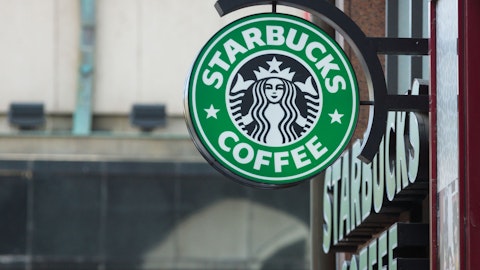Ricardo Cardenas: Yes, Brian, I won’t necessarily talk about 23. I’ll just talk about what we’re seeing, not being an economist, I listen to what they have to say. But as you all know, everybody on this call knows, consumer spending drives the U.S. economy. The — we’ve seen a shift in spending though, from durable household goods or durable goods to leisure services, and the restaurant industry has benefited from that shift. Casual dining same-restaurant sales improved from Q1 to Q2 and our positive gap to the industry improved even more during that time. So one of the benefits of our portfolio, as you mentioned, is we have a wide range of consumers. We serve a lot of them all across all of the spectrum. And our data indicates the higher-end consumer hasn’t seen the same impact as consumers at the lower end of the spectrum.
But if you think about the prepared remarks, sales at Thanksgiving were a record for Fine Dining and Seasons 52 and bookings for this holiday season are encouraging. So it seems like the higher end consumer is doing pretty well. And I know there’s been a lot of talk over the year about consumers that’s below $50,000 in income because high inflation impacts that consumer more disproportionately, but we’ve seen a little softness in that consumer over the last 6 months, but the mix of the 50,000 income and under is still above pre-covid levels for us. Even though that shift has come down a little bit, we’re still above pre-covid levels at the 50,000 and below. And I would say, keep in mind that a lot of our consumers below $50,000 are single, are retirees are living in multigenerational households.
So maybe $50,000 goes a little bit farther for that consumer. But without commenting on the future, we have seen a pretty good performance across all of those consumers over the last few months other than the fact that the 50,000 below consumer is lower than it was 6 months ago, but still higher than it was pre.
Operator: We’ll take our next question from Andrew Charles of Cowen.
Andrew Charles: Great. Notwithstanding the strong 2Q performance and the higher fiscal 2023 guidance, but if we were to see some macro deterioration impact the industry in fiscal 2020 — your calendar 2023, excuse me, what’s kind of the pecking order or your preference of magnitude of how you’d respond to that? Should we expect perhaps a tighter taking of the belt and just more of a focus on reducing overhead? Will we expect you guys to potentially invest more in the marketing, potentially invest more to value. How do you think about the contingency plan if we were to see some deterioration in calendar 2023?
Ricardo Cardenas: Andrew This is Rick again. If we see deterioration in the calendar 2023, we always look at ways to tighten and find ways to improve productivity and improve our administrative expenses. We think we’re actually really good at doing that. So if something gets really — shifts really badly in the wrong way, we’re going to find ways to at least find places to tighten. On the marketing spend, Raj talked about what our marketing spend is for the rest of this year and for the whole year. We don’t anticipate making a big change in that no matter what happens over the next 6 months. We’re going to continue to use the filters that we mentioned. And I will say Olive Garden, as I said before, we’ll always have advertising in their mix because of their scale.
But we’re going to stick to our strategy of core growth. We’re going to react accordingly to whatever happens. And as we’ve said in the past, and Raj said it too, if and when we increase our marketing spend, we’ll expect it to return — to earn a return compared to what it would have been without the spend. So we’re going to — as you’ve seen us in the past, we react when things happen, and we think we’ll do the same thing going forward.
Andrew Charles: Very helpful. And if I could sneak one in to Raj, what’s the small step hire in CapEx guidance as you maintain new store openings? Is that construction costs were perhaps running a bit higher than expected, there are some incremental investments in technology or something else we should be thinking about?
Rajesh Vennam: It’s truly inflation on the construction costs and some equipment costs as well. So it’s really — a lot of it is new restaurant related. Some is on the — even on the facilities CapEx, there’s a little bit higher inflation.
Operator: We’ll take our next question from David Palmer with Evercore ISI.
David Palmer: Just a question on traffic, particularly on-premise. If you look at the industry numbers, on-premise traffic is down double digits for casual dining. And even Olive Garden is not back to where it was. I wonder how that informs your strategy? Do you feel like that’s an opportunity? Or you just have to be patient, particularly with some lapsed users, maybe that under 75,000 household income user but maybe this isn’t something you want to chase either. So I’m wondering how you view that as opportunity that informs the strategy.
Ricardo Cardenas: David, if you think about what we’ve done over the last few years, we have significantly reduced marketing spending at Olive Garden. And we’ve talked in the past at how that could be about a 10-point drop in traffic for us. But we’re focusing on driving core users to Olive Garden, core gas versus promotional users. And so what we see as an opportunity, we’ve got more capacity in our restaurants than we did before. But a lot of that in-restaurant experience has moved to the off-premise experience. As you see Olive Garden still at 25% off-premise where prior to COVID, it was much lower than that. So we see it as an opportunity to continue to focus on our strategy of pricing below our competition, pricing below inflation by finding other cost savings to help offset that and give our consumers a great value so they don’t need a promotional message to come in and they just get a great value every time they come.





